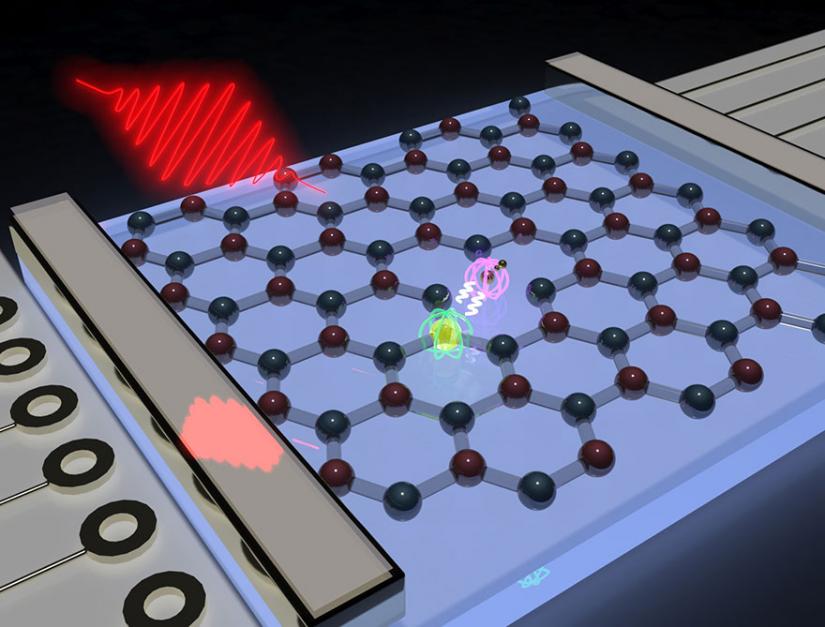Study puts spin into quantum technologies
The ability to manipulate and read out single electron spins in solids has the potential to advance applications in fundamental science, defence and industry—scientists say.
A team of international scientists investigating how to control the spin of atom-like impurities in 2D materials have observed the dependence of the atoms’ energy on an external magnetic field for the first time. The results of the study, published in Nature Materials, will be of interest to both academic and industry research groups working on the development of future quantum applications, the researchers say.
Researchers led by Prof Vladimir Dyakonov at the University of Würzburg in collaboration with scientists from the University of Technology Sydney (UTS), the Kazan Federal University and the Universidade Federal de Minas Gerais, demonstrated the ability to control the spin of atom-like impurities in 2D material hexagonal boron-nitride. By combining laser and microwave excitation the researchers were able to change the spin states, for example “up” to “down”, of atom-like impurities hosted in the material and show the dependence of their energy on an external magnetic field.

UTS research highlights how scientists are quickly becoming masters in the craft of manipulating objects in the quantum field. Image credit Dr M Kianinia.
To put this research in context the authors highlight the 2005 proposal by, Boris Chernobrod and Gennady Berman who theorised the possibility of using the spin of single atoms to measure magnetic fields at the nanoscale. This nano-magnetometer relies on the idea that, owing to unique quantum properties, certain atom-like impurities in solid hosts emit light that varies in intensity in the presence of an external magnetic field. The first experimental demonstration of the concept dates back to 2008 and makes use of one such peculiar atom-like defect—the nitrogen-vacancy (NV) centre in diamond. The technique has since been perfected in diamond, and beyond fundamental applications, for example measuring the magnetic field of single electrons, it has been used in practical ways such as the first GPS-free quantum navigation system.
The work by Dyakonv and collaborators marks the first time that deterministic spin manipulation has been observed in a material that is made of a single sheet of atoms like graphene.
Authors of the current study say that this newly demonstrated quantum spin-optical properties, combined with the ease of integrating with other 2D materials and devices, establishes hexagonal boron-nitride as an intriguing candidate for advanced quantum technology hardware.
“2D atomic crystals are currently some of the most studied materials in condensed matter physics and materials science,” says UTS physicist Dr Mehran Kianinia, a co-author of the study.
“Their physics is intriguing from a fundamental point of view, but beyond that, we can think of stacking different 2D crystals to create completely new materials, heterostructures and devices with specific designer properties,” he says.
UTS researcher, Dr Carlo Bradac, a senior co-author of the study says that in addition to adding another unique property, to an already impressive range of properties for a 2D material, the discovery has enormous potential for the field of quantum sensing.
“What really excites me is the potential [in the context of quantum sensing]. These spins are sensitive to their immediate surroundings. Unlike 3D solids, where the atom-like system can be as far as a few nanometres from the object to sense, here the controllable spin is right at the surface. Our hope is to use these individual spins as tiny sensors and map, with unprecedented spatial resolution, variations in temperature, as well as magnetic and electric fields onto variations in spin” Dr Bradac says.
“Imagine, for instance, being able to measure minuscule magnetic fields with sensors as small as single atoms. The possibilities are far reaching and range from nuclear magnetic resonance spectroscopy for nanoscale medical diagnostic and material chemistry to GPS-free navigation using the Earth’s magnetic field,” he says.
However quantum-based nanoscale magnetometry is “just one area where controlling single spins in solids is useful” says senior author of the study UTS Professor Igor Aharonovich.
“Beyond quantum sensing, many quantum computing and quantum communication applications rely on our ability to control the spin-state—zero, one and anything in between—of single atom-like systems in solid host materials. This allows us to encode, store and transfer information in the form of quantum bits or qubits,” he says.
Amongst many others, this research highlights how scientists are quickly becoming masters in the craft of manipulating objects in the quantum regime. In fact, achievements like Lockheed Martin’s Black Ice project and Google’s quantum supremacy are proof that we are striding away from mere proof-of-concept experiments towards real world, quantum-enabled solutions to practical problems.
Funding
Würzburg-Dresden Cluster of Excellence on Complexity and Topology in Quantum Matter
Alexander von Humboldt (AvH) Foundation, The Australian Research Council, the Asian Office of Aerospace Research and Development, Office of Naval Research Global
Publication details
Initialization and read-out of intrinsic spin defects in a van der Waals crystal at room temperature Andreas Gottscholl, Mehran Kianinia, Victor Soltamov, Sergei Orlinskii, Georgy Mamin,Carlo Bradac, Christian Kasper, Klaus Krambrock Andreas Sperlich , Milos Toth, Igor Aharonovich and Vladimir Dyakonov Nature Materials DOI 10.1038/s41563-020-0619-6
https://nature.com/articles/s41563-020-0619-6
